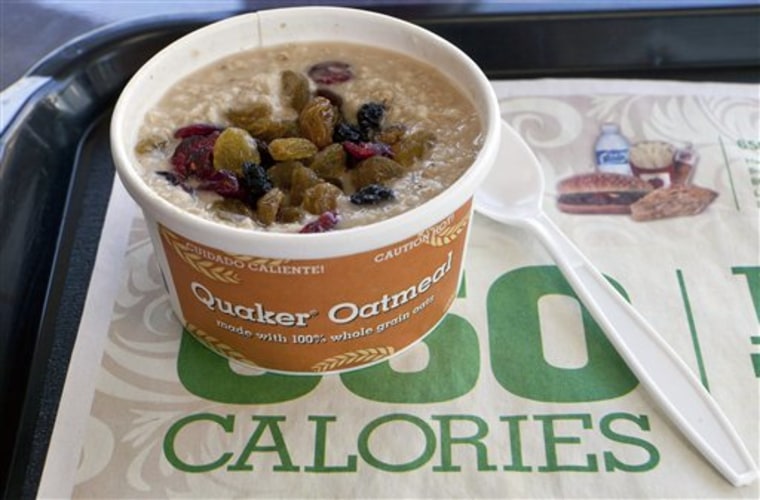Burger King is advertising fresh vegetables and introducing oatmeal, McDonald’s is touting "real fruit" smoothies and Wendy’s is promoting “natural” lemonade and summer salads.
Times are changing at fast-food restaurants — sort of.
Spurred in part by the success of restaurants like Subway and Chipotle, who have found a winning formula in offering fresh, made-to-order items, fast-food chains better known for their greasy fries and gut-busting burgers are increasingly paying attention to avocado slices and apple wedges.
The shift toward fresher food comes as the giant chains gird for expected fierce competition in the years to come. The U.S. foodservice market is likely to grow less than 1 percent a year over the next decade, according to research firm NPD Group.
“It’s going to be a real battle for market share,” said Bonnie Riggs, restaurant industry analyst with NPD.
That’s left fast-food restaurants eager to attract more Americans of all ages and walks of life — from weight-conscious teens to heart-conscious baby boomers — who say they want fresh food and higher-quality ingredients.
“I think it’s more of an attitudinal shift than a demographic shift,” said Robert Passikoff, founder of market research firm Brand Keys. “You’ve got teenagers who are just as aware of calories and fat count and sugar count as parents.”
Burger King, well-known for , last week announced an advertising scheme that would be more "food-centric," featuring images of fresh veggies and other ingredients. This week, it added oatmeal to its menus.
There’s also a marketing element to the moves. As more chains are asked to provide calorie counts on websites or in stores, restaurant operators are eager to show they have lower-calorie options, Riggs said.
But that doesn't mean customers necessarily want to take advantage of them. When NPD asked customers what they were looking for in healthy offerings, the No. 1 answer was “fresh ingredients," Riggs said.
“I think it was an eye-opener for many of us … that it wasn’t all about calories and salt and low fat and those things that we thought it would be,” she said.
That may explain why some fast-food makers have recently started showcasing beautiful pictures of fresh vegetables and touting real fruits without necessarily making their offerings low-calorie.
That Wendy’s lemonade may be made with sugar and lemon juice instead of high fructose corn syrup, but a large cup of it still packs 410 calories.
And the California Whopper Burger King began touting this week in a commercial filled with lush shots of fresh veggies? It also comes with bacon and other ingredients, all of which add up to 820 calories.
This fast-food version of healthy foods has drawn its share of critics. New York Times food columnist Mark Bittman earlier this year described McDonald’s oatmeal as “oats, sugar, sweetened dried fruit, cream and 11 weird ingredients you would never keep in your kitchen.”
Still, the 290-calorie dish has about half the calories as McDonald’s hotcakes and sausage with syrup. In its latest earnings report McDonald's credited oatmeal with helping to improve its U.S. breakfast sales.
McDonald’s says it has been working to make food healthier for years, pointing to moves such as reducing sodium in chicken McNuggets and phasing out super-size options.
But the fast-food behemoth has recently stepped up its efforts with initiatives such as a pledge to offer a healthier version of its children’s Happy Meal, which will now feature a smaller portion of french fries along with apple slices.
Cindy Goody, senior director of nutrition for McDonald’s USA, said the goal is to offer a variety of choices. She noted, for example, that someone craving a burger could choose anything from the 250-calorie basic hamburger to the 790-calorie Angus Bacon & Cheese.
Goody said the company also has traditionally made an especially strong effort to appeal to children and the moms who buy their food.
Those efforts appear to be paying off. Passikoff, the brand analyst, said his research has shown that McDonald’s ranks No. 1 for customer perception of brand value and healthy choice. Subway ranks second.
Passikoff said McDonald’s has traditionally been good at spotting new food trends, such as this one, although it can take a while for the company to perfect the taste part.
“McDonald’s has always been one who has been quick to market but slow to delight,” he said.
Still, that puts the fast-food giant in a better position than some other competitors, who are only now realizing that offering an average-tasting burger for a low price may not be enough, Passikoff said.
That may be part of what was behind Burger King’s decision to adopt a more "food-centric" advertising campaign and introduce its own version of oatmeal nationwide. The company saw U.S. and Canadian same-store sales fall 5.3 percent in the most recent quarter.
But the company may not be completely abandoning its more traditional focus. A spokesman for Burger King said in an e-mail that the company could still bring back its former advertising mascot, the King, at a later time.
Other fast food joints also are taking steps to offer healthier options.
Jack in the Box's ads may still be aimed at young men with but it has said it will make apple bites with caramel an option with its kids meals. And Carl’s Jr. and Hardee’s are now offering turkey burgers as well as beef, although they're also using .
Riggs, of NPD, expects that anyone who hasn’t yet jumped on the fresh-food bandwagon may just watching to see if it pays off for their competitors before following suit.
“This is such a me-too industry,” she said.
